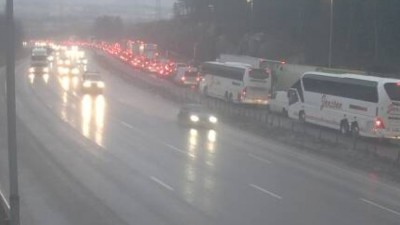UPDATED: Traffic in much of southern Norway, including the entire Oslo metropolitan area, was all but paralyzed Tuesday morning after a sudden change in the weather. Temperatures rose during the night and then it started to rain. When the rain hit frozen ground and roads, it instantly froze as well, creating treacherous black ice that sent vehicles sliding out of control and pedestrians slipping and falling. The E6 northbound from Oslo closed again just before 2pm on Tuesday, after an accident involving a truck, and police said it would “take awhile” to clear the slippery road.

Cars slid off roads and into ditches, couldn’t stop from running into each other and spun full round on highways. Entire bus systems ground to a halt. Police sent out urgent warnings of extremely slippery roads, and pleaded with commuters to not even attempt driving.
“It’s incredibly slippery out there,” Ronny Årstein, operations leader for the Romerike Police District northeast of Oslo, announced on state broadcaster NRK. “Let your car stay parked and take the train today.” It wasn’t easy to get to the train stations, though.
Police in Romerike, Follo, Oslo, Asker and Bærum issued similar pleas, after also reporting a string of collisions. No one was seriously hurt, but a truck landed on its side after its driver lost control on the usually busy multi-lane E6 highway at Skedsmo, north of Oslo. Police had to close the road and it took time to reopen it, since the truck was carrying a heavy load of tax-free goods to the airport at Gardermoen. Emergency crews were faced with emptying the truck before it could be uprighted.

Most all of the bus routes in Romerike, meanwhile, were halted because it was deemed too dangerous to drive on the iced-over roads. Highway crews had been out all night salting main thoroughfares, but the steady rain simply washed the salt and sand away.
Bus service was disrupted all over the metropolitan area but slowly started up again later in the morning. Delays and cancellations were predicted throughout the day, according to the Ruter transit system that runs them. Many airline passengers bound for the airport at Gardermoen missed their flights as they sat on an airport bus that in turn was unable to operate.
Tow-truck company Viking had to deal with more than 500 calls for help on Tuesday because of trouble on the slippery roads, fully 80 percent of them in the Oslo area.
‘Lots of broken bones’
Emergency clinics faced a rush of injured pedestrians who had fallen on the ice. Dr Marianne Hulby at the Ahus hospital in Akershus reported 21 patients waiting in line at around 10:30am, with suspected fractures and concussions. The situation was the same at the Legevakt emergency hospital in Oslo. “We have lots of broken bones,” Dr Knut Melhuus told NRK.
On Holmenveien in Oslo, pedestrians tried holding on to fences, trees and each other to stay on their feet, while at least two busses slid off the road and cars spun out of control.
The phenomoenon of rain freezing on contact with the ground is known as underkjølt regn in Norwegian and it’s difficult both to predict and control. Anita Agger-Wick of the the state meterological institute at Blindern in Oslo said temperatures were rising throughout the day and that would help ease driving conditions. Inland areas remained cold without the rain that hit coastal areas and the Oslo region so hard. Warnings were still up for Drammen and Kongsberg, and there were widespread regional differences.
newsinenglish.no/Nina Berglund

